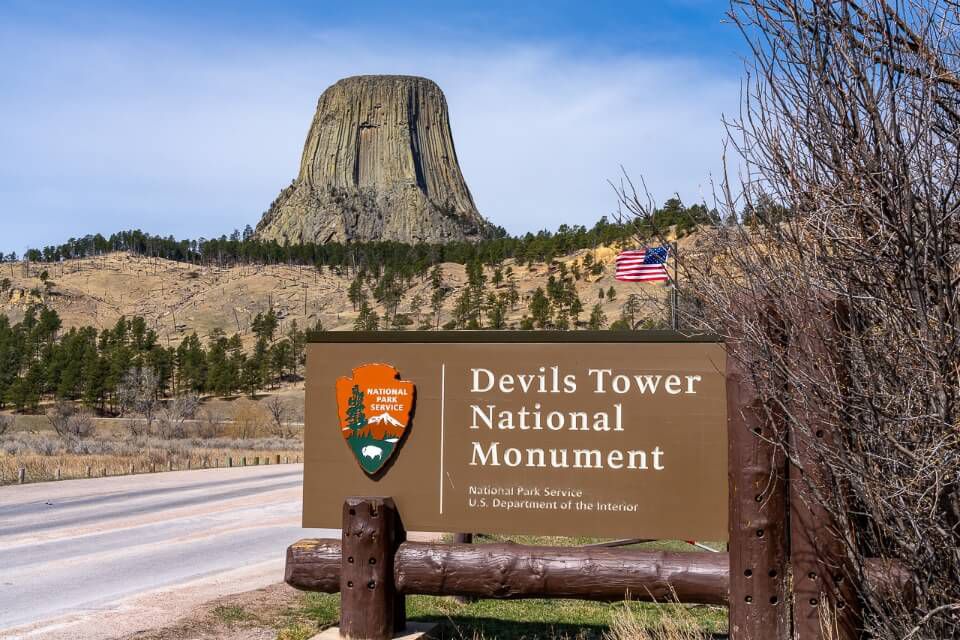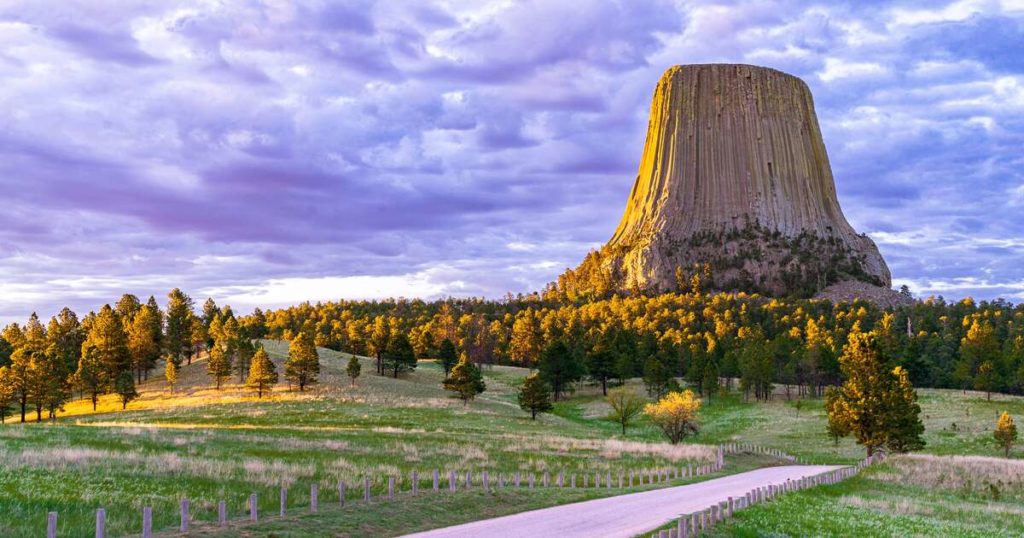Nestled in the picturesque landscape of Wyoming, the Devil’s Tower stands as an iconic symbol of natural wonder and mystery. As a prominent National Monument, the Devil’s Tower captures the imagination of visitors with its sheer size, intriguing formation, and rich history. Situated near the town of Hulett, Wyoming, this geological marvel has fascinated geologists, climbers, and curious travelers for generations. In this blog, we delve into the depths of what the Devil’s Tower is, its formation, historical legends, and the story behind its name, and even offer you a perfect place to stay during your visit.
What Is Devil’s Tower?
The Devil’s Tower, also known simply as “Devil’s Tower,” is a towering geological formation that stands as an awe-inspiring monolith in northeastern Wyoming, United States. It rises majestically from the surrounding landscape, capturing attention with its unique appearance. This natural wonder is designated as a National Monument, attracting thousands of visitors each year who come to witness its grandeur up close. Rising to a height of 867 feet, the Devil’s Tower is a sight to behold.
The Devil’s Tower, a striking National Monument in Wyoming, captures the essence of natural beauty, geological wonder, and historical significance. From its formation through the cooling of volcanic magma to the legends that add a touch of magic to its existence, the tower stands as a testament to the forces that have shaped our planet. As you plan your journey to witness this remarkable formation, consider making Black Hawk Creek RV Park & Cabins your home base. Your adventure to the Devil’s Tower and beyond will be enriched by the comfort and convenience this welcoming park has to offer. Explore the mysteries of the Devil’s Tower and create memories that will last a lifetime.
How Was Devil’s Tower Formed?

The formation of the Devil’s Tower is a tale woven by the forces of nature over millions of years. It is classified as an igneous intrusion, which means it was formed from molten rock that pushed its way up through the Earth’s crust and cooled over time. This type of geological phenomenon is responsible for the tower’s distinctive hexagonal columns.
Around 50 million years ago, volcanic activity in the region was intense. Molten rock, known as magma, was forced into existing rock layers beneath the surface. As the magma slowly cooled and solidified, it contracted and cracked, creating the iconic columns that give the Devil’s Tower its remarkable appearance. These columns are a result of the rock’s tendency to crack along vertical lines as it contracts, forming hexagonal shapes that stack upon one another, creating the tower’s breathtaking structure.
Is There Life on Devil’s Tower?
Wildlife actually inhabits the pinnacle, and atop this natural formation thrive indigenous grasses, cacti, and sagebrush. The expansive and undulating apex of the Devils Tower boasts an array of rocks, verdant grasses, resilient cacti, delicate wildflowers, and intriguingly, sagebrush – to be specific, the Wyoming big sagebrush, scientifically known as Artemisia tridentata ssp wyomingensis. This revelation may raise eyebrows due to the scarcity of big sagebrush within the confines of the Black Hills region, where it’s confined to the peripheries of this geological uplift. Its prevalence is typically associated with drier environs within the western basins. This discrepancy is notable as the Black Hills, even at lower elevations, tend to exhibit a more mesic (moist) nature, characterized by forests, woodlands, and comparatively lush mixed-grass prairies, reminiscent of the Great Plains found to the east.
Historical Legends of Devil’s Tower
Throughout history, the Devil’s Tower has held a significant place in the narratives of various Native American tribes. One of the most famous legends is that of the Lakota Sioux people. According to their folklore, a group of young girls were chased onto a rock by a massive bear. To escape the bear’s advances, the girls prayed fervently to the Great Spirit, who caused the rock to rise towards the heavens, lifting them out of the bear’s reach. The bear’s claws left the distinctive vertical grooves that mark the tower’s sides. This legend not only explains the tower’s origin but also adds an air of mystique to its existence.
The enduring presence of the bear in Native American sacred tales played a pivotal role in assigning the monument’s original name by the neighboring Native American communities—a name that continues to carry profound significance in contemporary times.
Nowadays, a visit to Devil’s Tower promises an enriching exploration of Native American culture. Throughout the year, various traditional and contemporary cultural and spiritual ceremonies, such as prayer offerings, vision quests, and the Sun Dance, continue to be conducted on the premises. Devil’s Tower the historic national monument remains a vibrant, sacred site, holding profound spiritual and cultural value for more than two dozen Native American tribes.
How Devil’s Tower Got Its Name

Originally known as Mato Tipila, meaning “Bear Rock,” “Bear Lodge,” or “Bear Tipi” in Native American cultural narratives, Devil’s Tower held profound significance. However, during the American Gold Rush in 1875, Colonel Richard Irving Dodge led an expedition to the region in response to gold claims in the Black Hills.
Dodge referred to it as “The Bad God’s Tower,” a name he believed was suitable. His geological assistant, Henry Newton, concurred, noting that while it was known as “Mato Tipila” among the Indians, it had more recently been referred to as “The Bad God’s Tower” or, in plainer English, “The Devil’s Tower.”
Despite the monument’s original name, “Bear Lodge,” being documented in various records and maps, “Devil’s Tower” gained popularity and became the prevailing name.
The discrepancy likely stemmed from a translation error. Most Native American names for the site relate to bears in some manner. In the Lakota language, “wakansica” means “bad god” or “evil spirit,” while “wahanksica” translates to “black bear.” Given that the Lakota were a prominent Native American community in the area, it’s conceivable that Dodge misunderstood the name, unintentionally altering the region’s history by replacing a culturally significant name with an inaccurate yet catchy interpretation.
Today, many Native American tribal organizations advocate for renaming the tower to honor its original title and cultural heritage.
Need a Place to Stay on Your Way to Devil’s Tower?
Planning a visit to the Devil’s Tower and the surrounding attractions, such as Mount Rushmore, Custer State Park, and Crazy Horse, requires a comfortable and convenient place to stay. Look no further than Black Hawk Creek RV Park & Cabins. Situated just 5 minutes away from Rapid City, this park offers an ideal location for exploring the region’s iconic landmarks. Whether you prefer the coziness of cabins or the convenience of RV sites, Black Hawk Creek RV Park & Cabins provides a range of accommodation choices to suit your needs. Open year-round, this park welcomes travelers with its warm hospitality and proximity to the breathtaking Devil’s Tower.

